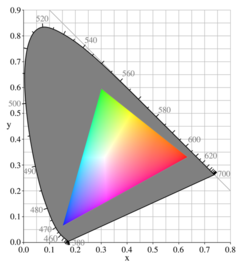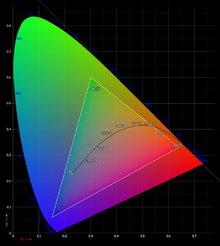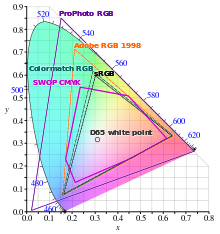


Incolor reproduction and colorimetry, a gamut, or color gamut /ˈɡæmət/, is a convex set containing the colors that can be accurately represented, i.e. reproduced by an output device (e.g. printer or display) or measured by an input device (e.g. camera or visual system). Devices with a larger gamut can represent more colors. Similarly, gamut may also refer to the colors within a defined color space, which is not linked to a specific device. A trichromatic gamut is often visualized as a color triangle. A less common usage defines gamut as the subset of colors contained within an image, scene or video.
The term gamut was adopted from the field of music, where in middle age Latin "gamut" meant the entire range of musical notes of which musical melodies are composed; Shakespeare's use of the term in The Taming of the Shrew is sometimes attributed to the author / musician Thomas Morley.[1] In the 1850s, the term was applied to a range of colors or hue, for example by Thomas de Quincey, who wrote "Porphyry, I have heard, runs through as large a gamut of hues as marble."[2]
The gamut of a device or process is that portion of the color space that can be represented, or reproduced. Generally, the color gamut is specified in the hue–saturation plane, as a system can usually produce colors over a wide intensity range within its color gamut; for a subtractive color system (such as used in printing), the range of intensity available in the system is for the most part meaningless without considering system-specific properties (such as the illumination of the ink).
Device gamuts must use real primaries (those that can be represented by a physical spectral power distribution) and therefore are always incomplete (smaller than the human visual gamut). No gamut defined by a finite number of primaries can represent the entire human visual gamut. Three primaries are necessary for representing an approximation of the human visual gamut. More primaries can be used to increase the size of the gamut. For example, while painting with red, yellow and blue pigments is sufficient for modeling color vision, adding further pigments (e.g. orange or green) can increase the size of the gamut, allowing the reproduction of more saturated colors.
While processing a digital image, the most convenient color model used is the RGB model. Printing the image requires transforming the image from the original RGB color model to the printer's CMYK color model. During this process, the colors from the RGB model which are out of gamut must be somehow converted to approximate values within the CMYK model. Simply trimming only the colors which are out of gamut to the closest colors in the destination space would burn the image. There are several algorithms approximating this transformation, but none of them can be truly perfect, since those colors are simply out of the target device's capabilities. This is why identifying the colors in an image that are out of gamut in the target color space as soon as possible during processing is critical for the quality of the final product. It is also important to remember that there are colors inside the CMYK gamut that are outside the most commonly used RGB color spaces, such as sRGB and Adobe RGB.
Color management is the process of ensuring consistent and accurate colors across devices with different gamuts. Color management handles the transformations between color gamuts and canonical color spaces to ensure that colors are represented equally on different devices. A device's gamut is defined by a color profile, usually the ICC profile, which relates the gamut to a standardized color space and allows for calibration of the device. Transforming from one gamut to a smaller gamut loses information as out-of-gamut colors are projected on to the smaller gamut and transforming back to the larger gamut does not regain this lost information.
Colorimetry is the measurement of color, generally in a way that mimics human color perception.[3] Input devices such as digital cameras or scanners are made to mimic trichromatic human color perception and are based on three sensors elements with different spectral sensitivities, ideally aligned approximately with the spectral sensitivities of human photopsins. In this sense, they have a similar gamut to the human visual system. However, most of these devices violate the Luther condition and are not intended to be truly colorimetric, with the exception of tristimulus colorimeters. Higher-dimension input devices, such as multispectral imagers, hyperspectral imagersorspectrometers, capture color at a much larger gamut, dimensionally, than the human visual gamut. To be perceived by humans, the images must first be down-dimensionalized and treated with false color.
The extent of color that can be detected by the average human, approximated by the standard observer, is the human visual gamut. The visual gamut is usually visualized in the CIE 1931 chromaticity diagram, where the spectral locus (curved edge) represents the monochromatic (single-wavelength) or spectral colors. As the device you are using to view the diagram has a smaller gamut than the visual gamut, the colors that are out-of-gamut are reproduced as colors inside the display's gamut. Device gamuts are generally depicted in reference to the visual gamut. The standard observer represents a typical human, but colorblindness leads to a reduced visual gamut.
 |
Gamuts are commonly represented as areas within the CIE 1931 chromaticity diagram. This ignores the intensity/brightness dimension of the gamut, which is not depicted. Gamuts defined by three primaries are visualized as color triangles. |
The sRGB gamut projected into the CIExyY color space. x and y are the horizontal axes and represent chromaticity. Y is the vertical axis and represents luminance. |
Gamuts may also be represented in 3D space as a color solid, which includes a visualization of the dynamic range of the device. |
|
Gamut of colors found in reflective surfaces in nature
|
The pictures show the gamuts of RGB color space (left), such as on computer monitors, and of reflective colors in nature (right). The cone drawn in grey corresponds roughly to the CIE chromaticity diagram, with the added dimension of brightness.
The axes in these diagrams are the responses of the short-wavelength (S), middle-wavelength (M), and long-wavelength (L) cones in the human eye. The other letters indicate black (Blk), red (R), green (G), blue (B), cyan (C), magenta (M), yellow (Y), and white colors (W). (Note: These pictures are not exactly to scale.) The right diagram shows that the shape of the RGB gamut is a triangle between red, green, and blue at lower luminosities; a triangle between cyan, magenta, and yellow at higher luminosities, and a single white point at maximum luminosity. The exact positions of the apexes depends on the emission spectra of the phosphors in the computer monitor, and on the ratio between the maximum luminosities of the three phosphors (i.e., the color balance). The gamut of the CMYK color space is, ideally, approximately the same as that for RGB, with slightly different apexes, depending on both the exact properties of the dyes and the light source. In practice, due to the way raster-printed colors interact with each other and the paper and due to their non-ideal absorption spectra, the gamut is smaller and has rounded corners. |
The gamut of reflective colors in nature has a similar, though more rounded, shape. An object that reflects only a narrow band of wavelengths will have a color close to the edge of the CIE diagram, but it will have a very low luminosity at the same time. At higher luminosities, the accessible area in the CIE diagram becomes smaller and smaller, up to a single point of white, where all wavelengths are reflected exactly 100 percent; the exact coordinates of white are determined by the color of the light source.


In the beginning of the 20th century, industrial demands for a controllable way to describe colors and the new possibility to measure light spectra initiated intense research on mathematical descriptions of colors.
The idea of optimal colors was introduced by the Baltic German chemist Wilhelm Ostwald. Erwin Schrödinger showed in his 1919 article Theorie der Pigmente von größter Leuchtkraft (Theory of Pigments with Highest Luminosity)[4] that the most-saturated colors that can be created with a given total reflectivity are generated by surfaces having either zero or full reflectance at any given wavelength, and the reflectivity spectrum must have at most two transitions between zero and full.
Thus two types of "optimal color" spectra are possible: Either the transition goes from zero at both ends of the spectrum to one in the middle, as shown in the image at right, or it goes from one at the ends to zero in the middle. The first type produces colors that are similar to the spectral colors and follow roughly the horseshoe-shaped portion of the CIE xy chromaticity diagram, but are generally less saturated. The second type produces colors that are similar to (but generally less saturated than) the colors on the straight line in the CIE xy chromaticity diagram, leading to magenta-like colors.
Schrödinger's work was further developed by David MacAdam and Siegfried Rösch [Wikidata].[5] MacAdam was the first person to calculate precise coordinates of selected points on the boundary of the optimal color solid in the CIE 1931 color space for lightness levels from Y = 10 to 95 in steps of 10 units. This enabled him to draw the optimal color solid at an acceptable degree of precision. Because of his achievement, the boundary of the optimal color solid is called the MacAdam limit (1935).
In 1980, Michael R. Pointer published a maximum gamut for real surfaces with diffuse reflection using 4089 samples, (surfaces with specular reflection ("glossy") can fall outside of this gamut).[6] Originally called a "Munsell Color Cascade", the limits are more commonly called Pointer's Gamut after his work. This gamut remains important as a reference for color reproduction,[7] having been updated by newer methods in ISO 12640-3 Annex B.[8]
On modern computers, it is possible to calculate an optimal color solid with great precision in seconds. The MacAdam limit, on which the most saturated (or "optimal") colors reside, shows that colors that are near monochromatic colors can only be achieved at very low luminance levels, except for yellows, because a mixture of the wavelengths from the long straight-line portion of the spectral locus between green and red will combine to make a color very close to a monochromatic yellow.
Light sources used as primaries in an additive color reproduction system need to be bright, so they are generally not close to monochromatic. That is, the color gamut of most variable-color light sources can be understood as a result of difficulties producing pure monochromatic (single wavelength) light. The best technological source of monochromatic light is the laser, which can be rather expensive and impractical for many systems. However, as optoelectronic technology matures, single-longitudinal-mode diode lasers are becoming less expensive, and many applications can already profit from this; such as Raman spectroscopy, holography, biomedical research, fluorescence, reprographics, interferometry, semiconductor inspection, remote detection, optical data storage, image recording, spectral analysis, printing, point-to-point free-space communications, and fiber optic communications.[9][10][11][12]
Systems that use additive color processes usually have a color gamut which is roughly a convex polygon in the hue-saturation plane. The vertices of the polygon are the most saturated colors the system can produce. In subtractive color systems, the color gamut is more often an irregular region.
This section needs additional citations for verification. Please help improve this articlebyadding citations to reliable sources in this section. Unsourced material may be challenged and removed. (April 2007) (Learn how and when to remove this message)
|

Following is a list of representative color systems more-or-less ordered from large to small color gamut:
The Ultra HD Forum defines a wide color gamut (WCG) as a color gamut wider than that of BT.709 (Rec. 709).[17] Color spaces with WCGs include:
The print gamut achieved by using cyan, magenta, yellow, and black inks is sometimes a limitation, for example when printing colors of corporate logos. Therefore, some methods of color printing use additional ink colors to achieve a larger gamut. For example, some use green, orange, and violet inks to increase the achievable saturation of hues near those. These method are variously called heptatone color printing, extended gamut printing, and 7-color printing, etc.[20][21]
gamut-of-hues 0-1856.
|
Color topics
| ||||||||||
|---|---|---|---|---|---|---|---|---|---|---|
| Color science |
| |||||||||
| Color philosophy |
| |||||||||
| Color terms |
| |||||||||
| Color organizations |
| |||||||||
| Names |
| |||||||||
| Related |
| |||||||||
| ||||||||||